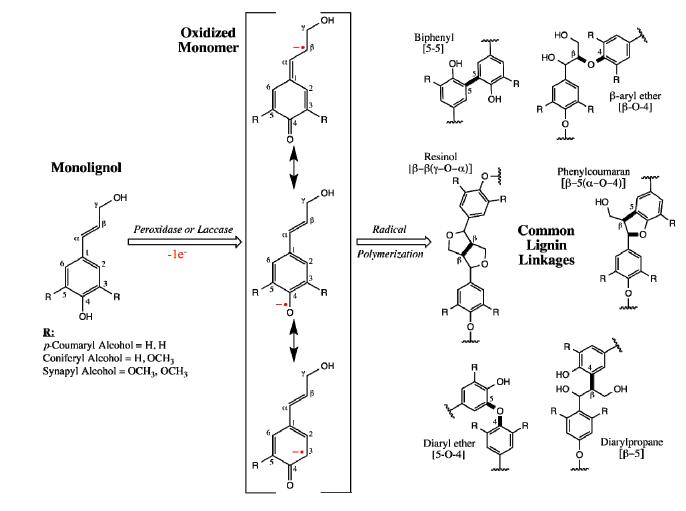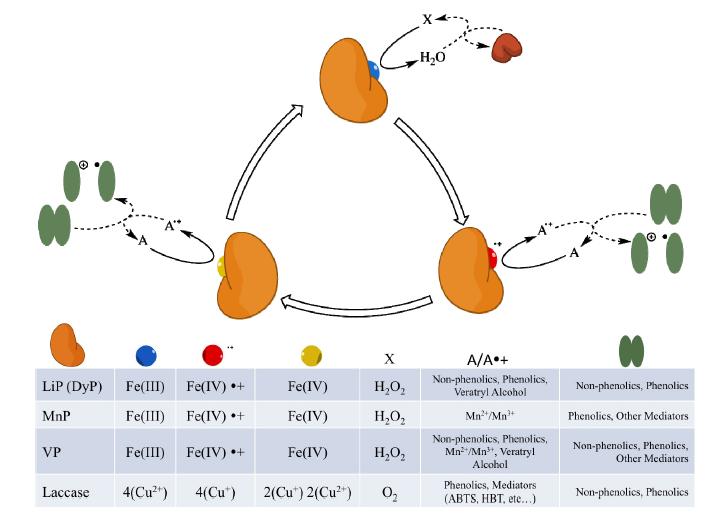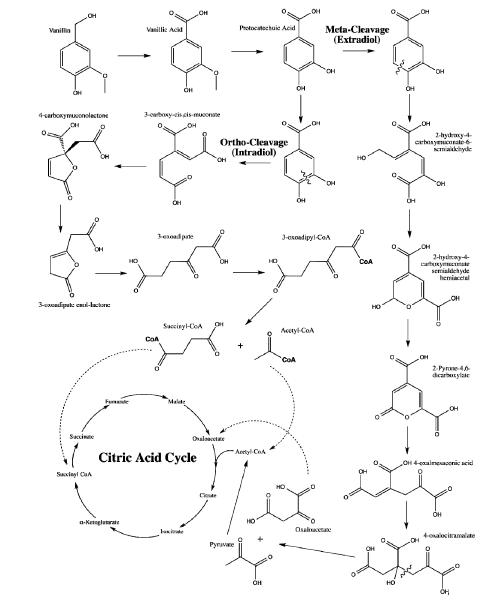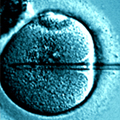Abbreviations:
H, p-hydroxyphenol; G, guaiacyl; S, syringyl; AFM, atomic force microscopy; SANS, small-angle neutron scattering; NMR, nuclear magnetic resonance; EC, enzyme commission; LiP, lignin peroxidase; MnP, manganese peroxidase; VP, versatile peroxidase; DyP, dye-decolorizing peroxidase; ABTS, 2,2’-azino-bis (3-ethylbenzothiazoline-6-sulphonic acid); HBT, hydroxybenzotriazole; AAPL, acid precipitable polymeric lignin; [C2mim]Cl, 1-ethyl-3-methylimidazolium chloride; [C2mim]OAc, 1-ethyl-3-methylimidazolium acetate; CBP, consolidated bioprocessing
1. Introduction
Lignocellulose, which comprises the cell walls of plants, is the Earth’s most abundant renewable source of convertible biomass. The United States agricultural and forestry industries sustainably produce more than 1.3 billion annual tonnes of lignocellulosic biomass that—when combined with l and -use management and advances in biomass-conversion—could meet the national dem and for liquid transportation fuel without detriment to the food, feed or fiber industries [1,2]. Biofuels research has demonstrated effective strategies for the conversion of biomass into biofuels, with the first cellulosic ethanol industrial plant based in Italy now producing 75 million liters per year of cellulosic ethanol [3,4]. However, cellulosic biofuels face several technical and economic obstacles, not the least of which is the recalcitrant lignin fraction of lignocellulosic biomass that must be removed before the fermentable sugars within the cellulose and hemicellulose fractions can be accessed [5]. Research has identified potential ligninolytic organisms and enzymes, but the mechanistic details associated with enzymatic lignin degradation remain unclear. As such, commercial-scale bioprocesses for lignin depolymerization and transformation have yet to be developed. Further, lignin effluent streams are currently used for combustion and internal energy production in biorefineries exceeds dem and by 60% [6]. As the only large-volume renewable feedstock of aromatics, processes to create volume-added products from depolymerized lignin would vastly enhance the economics of lignocellulose biomass [6]. Here we discuss background on lignin, the enzymology of lignin degradation, and characterized catabolic pathways for metabolizing the by-products of lignin degradation. To conclude we survey advances in approaches to identify novel lignin degrading phenotypes and to apply these phenotypes in the lignocellulosic biorefinery.
2. Lignin
Lignocellulose consists of two carbohydrate polymers, cellulose and hemicellulose, and the non-carbohydrate, aromatic heteropolymer lignin. Cellulose and lignin are the most and second most abundant biopolymers on Earth, respectively. By mass, cellulose makes up 30-50% of lignocellulose while lignin contributes as much as 30% and accounts for ~20% of the total carbon fixed by photosynthesis [7,8]. In the plant cell lignin is biosynthesized from three hydroxycinnamyl alcohol monomers or monolignols: p-coumaryl alcohol, coniferyl alcohol and sinapyl alcohol (Figure 1.). These monolignols (along with less abundant, acylated versions) are oxidatively coupled into lignin oligomers consisting of phenylpropanoid subunits: p-hydroxyphenol (H), guaiacyl (G) and syringyl (S) (from p-coumaryl alcohol, coniferyl alcohol and sinapyl alcohol, respectively). These three monolignols differ in their degree of methoxy group substitutions, which protect locations from the nonspecific radical coupling reactions that polymerize lignin [9,10]. Consequently, the relative intracellular concentrations of the various monolignols influence the resultant composition and structure of lignin in individual plants. For example, grasses assemble lignin from G, S, and H monomers, hardwood contains roughly equal parts G and S, and softwood is up to 90% G [10]. The linkages formed during radical coupling of lignin monomers varies between species and can be either C-C or C-O ether linkages, though typically more than two-thirds of bonds are ether bonds [11]. As the phenolic and β-hydrogen are shared between G, S, and H these sites participate in most of the bonding, with the β-aryl ether (e.g., β-O-4) linkage estimated to represent up to 80% of the bonding motifs found in lignin [12,13]. Once biosynthesized, lignin polymers cross-link with the polysaccharides of hemicellulose and cellulose to form the complex matrix, which provides the tissues and cell walls of all vascular plants strength, rigidity and protection from microbial degradation.
Extensive efforts have been made to underst and and reduce the complex heterogeneity of lignin. New advances in imaging and chemical analysis have illuminated the chemical and structural diversity of lignin. Two methods used for molecular-level analyses of lignin include coherent anti-Stokes Raman scattering—a label-free method to image at a spatial resolution of about 200 nanometers—and, while still in early development, mode-synthesizing atomic force microscopy (AFM) that combines the analytical resolution of AFM with spectroscopy [14,15]. Structural analysis of lignin is often accomplished using two-dimensional nuclear magnetic resonance (NMR), selective fragmentation and gas chromatography-mass spectrometry, pyrolysis molecular beam mass spectrometry and small-angle neutron scattering (SANS) [16,17,18,19,20]. Pyrolysis molecular beam mass spectrometry is a promising high-throughput methodology that requires minimal sample to analyze sugar content, lignin content and S:G ratios for compositional analysis [19]. Computational atomistic simulations and structural information provided by SANS have revealed fundamental physical processes of phase separation and aggregation of lignin during various thermochemical pretreatments of plant biomass [20]. While advances in NMR, LC-MS, GC-MS and spectrometric approaches have deeply improved knowledge of lignin structure, there remains a need for a true ‘molecular sequencing’ method capable of identifying the less abundant monomers and linkages of lignin [21,22].
Along with increasing knowledge of the chemistry of lignin, concomitant advances in plant genetic engineering efforts have improved lignin properties for bioprocessing, pulping or forage digestibility [13,23,24,25,26,27]. Of the eleven enzymes involved in the conversion of L-phenylalanine to the primary monolignols, most have been down-regulated to yield transgenic plants featuring reduced lignin levels [23,28,29,30]. Additional approaches to reduce lignin content include targeting transcription factors, the supply of methyl groups or introducing novel enzymes that modify monolignols into non-polymerizing analogs [31,32,33]. While manipulation of lignin biosynthesis has sometimes come at the expense of plant health, decreasing lignin content by 50% or less from wild-type improved biomass digestibility enough to make pretreatment unnecessary for cellulosic saccharification [23,34,35]. Despite the essential role of lignin to plant health, the lignin biosynthetic pathway has proven to be a surprisingly plastic and pleiotropic phenotype [36,37,38]. It appears that mining mutant bioenergy crops in a forward genetic screening approach may reveal variants with physicochemical properties favorable for industrial processing [38]. Plant biomass that minimizes lignin cross-linking to cellulose and hemicellulose and reduces bond diversity will be critical to maximize the value of lignocellulose by improving lignin extraction and facilitating downstream processing [6].
3. Lignin degrading enzymes
Due to the branching, bulky three-dimensional structure and the C-C and C-O ether linkage heterogeneity of lignin, hydrolytic enzymes (like those responsible for the catabolism of linear cellulose and short-branching hemicellulose polysaccharides) cannot cleave lignin [39]. Similarly, low-potential oxidoreductases, such as the plant oxidases that initiate lignin polymerization, cannot oxidize the non-phenolic aromatic lignin subunits. These obstacles have constrained the evolutionary diversity of lignin-degrading microbial phenotypes to a limited set of specialized fungi and bacteria. Within lignin-degrading fungi and bacteria, several enzyme classes have been identified that are proposed to have ligninolytic activity [39,40,41]. While details surrounding the enzymology and distribution of these oxidative enzymes are beginning to be elucidated, the knowledgebase of ligninolytic enzymes still lags far behind the knowledge of cellulases.
4. Fungal lignin enzymology
The recognition and knowledge surrounding fungal lignin degradation exceeds its bacterial counterpart and is the basis for most ligninolytic research. Modification and degradation of lignin has been most extensively studied in the basidiomycetes, in particular the white-rot fungi and to a lesser extent the brown-rot fungi [42,43,44]. Phanerochaete chrysosporium is the model organism for lignin degradation by white-rot fungi, however several other species have been studied such as, Pleurotus ostreatus, Coriolus versicolor, Cyathus stercoreus, and Ceriporiopsis subvermispora [39,45]. Based upon this work in these organisms, families of peroxidases and laccases have been primarily implicated as ligninolytic enzymes.
The first ligninolytic enzyme isolated, lignin peroxidase (LiP, EC 1.11.1.14) was isolated from P. chrysosporium and found to be capable of oxidizing sites of particularly high redox potential, including the moderately-activated aromatic rings of non-phenolic model lignin compounds which can comprise up to 90% of the polymer (e.g., β-O-4 linkages) [46,47]. Wood-rot fungi produce two more extracellular ligninolytic peroxidases: manganese-dependent peroxidase (MnP, EC 1.11.1.13) and versatile peroxidase (VP, EC 1.11.1.16) [48,49]. MnP is unique from LiP in that it relies upon the generation of Mn3+ as a diffusible charge-transfer mediator and cannot oxidize non-phenolic lignin model compounds (but can reduce amines, dyes and phenolic lignin model compounds) [48,50,51,52]. VP are fittingly named, as they are capable of both LiP and MnP (manganese -independent and -dependent) catalytic activities, cleaving high redox potential nonphenolics, as well as lower potential aromatics and amines [49,53].
The catalytic cycle of the ligninolytic peroxidases is very similar to other peroxidases where the heme group reacts with hydrogen peroxide to form an oxo-ferryl intermediate (Figure 3.). However, there are two structural distinctions unique to the ligninolytic peroxidases. These enzymes possess a heme environment conferring an increased redox potential and binding sites specific to non-phenolic aromatics or Mn2+ in LiP or MnP, respectively [54]. For MnP the reduced Mn3+ is a widely accepted diffusible mediator, capable of oxidizing targets distanced from the enzyme active site [51,55]. The secretion of oxalic acid and other organic acids that chelate Mn3+ in stable complexes extends the range of the MnP oxidative activity [56]. It has been suggested that veratryl alcohol can act as a diffusible mediator for LiP, although the veratryl alcohol cation radical appears to have a very short half-life [57,58,59]. Dye-decolorizing peroxidases (DyP, EC 1.11.1.19) make up the most recently discovered class of heme-peroxidases occurring in fungi and bacteria, which share no sequence or structural similarity with other plant, fungal or bacterial peroxidases [60,61,62]. DyPs received their moniker from their ability to oxidize the high-redox potential anthraquinone dyes in addition to typical peroxidase substrates [60]. In complement to these peroxidase ligninolytic enzymes, white-rot fungi secrete accessory enzymes such as aryl-alcohol oxidase (veratryl alcohol oxidase; EC 1.1.3.7) from P. eryngii and glyoxal oxidase (EC 1.2.3.5) from P. chrysosporium that generate hydrogen peroxide required by the peroxidases [63,64]. In addition many fungi secrete oxidoreductases (such as quinone oxidoreductase [EC 1.1.5.1] and cellobiose dehydrogenase [EC 1.1.99.18]) capable of reducing the radical methoxy-groups of lignin-derived compounds [64,65].
The final and most divergent lignin-modifying enzyme class is the laccases (EC 1.10.3.2). Laccases are multi-copper oxidases produced by fungi, bacteria, plants and even insects that catalyze the one-electron oxidation of four equivalents of reducing substrate, with the corresponding four-electron reduction of atmospheric oxygen to water (Figure 3.) [66,67,68,69]. These versatile enzymes are able to oxidize aromatic phenols and amines, and in combination with mediators such as 2, 2’-azino-bis (3-ethylbenzothiazoline-6-sulphonic acid) (ABTS) and hydroxybenzotriazole (HBT) may even oxidize non-phenolic aromatic targets [70,71,72,73,74,75,76]. Fungal laccases are known to have higher redox potentials than bacterial laccases and are produced by a wide range of fungi. However, the biological role and significance of laccases in lignin degradation remains unclear. On the one h and P. chrysosporium—one of the most efficient ligninolytic microbes studied—contains no laccase homologs in it’s genome, yet on the other h and Pycnoporus cinnabarinus produces laccases but lacks apparent LiP or MnP and is still able to efficiently depolymerize lignin [77]. This discovery along with work in bacterial ligninolytic enzymology suggests that laccases may play a larger role in lignin degradation than traditionally acknowledged [40,41].
5. Bacterial ligninenzymology
Although recognition of the ligninolytic capacities of bacteria have certainly lagged behind their more active fungal counterparts, α-proteobacteria, γ-proteobacteria, some Firmicutes and, in particular, actinomycetes have been shown capable of modifying and degrading lignin [40,41,78,79]. Streptomyces viridosporus T7A, the best studied bacterial lignin degrader, produces several extracellular peroxidases that depolymerize lignin by cleaving β-aryl ether bonds resulting in the release of low molecular weight phenols [80,81,82]. Additionally, S. viridosporus T7A (along with several other bacteria) produces a water-soluble high molecular weight oxidation intermediate termed acid precipitable polymeric lignin (AAPL) [80,83]. Soil bacteria in the genera Rhodococcus and Nocardia were shown to release C14-CO2 from radioactively labeled lignin [78]. The cellulolytic thermophile, Thermobifida fusca partially degrades lignin when incubated with lignocellulosic pulps possibly by the action of a tat-dependently secreted thermostable DyP and is capable of forming APPL at levels exceeding S. viridosporus T7A [84,85]. Using novel spectrophotometric assays (discussed in detail below), Ahmad et al. identified Pseudomonas putida mt-2 and Rhodococcus jostii RHA1 as competent lignin degraders [79,86]. Further application of the assays highlighted the diversity in bacterial enzymology, as S. viridosporis T7A had a strong dependence on hydrogen peroxide for activity, while P. putida mt-2 and R. jostii RHA1 both showed activity in the absence of hydrogen peroxide—evidence for the presence of either hydrogen peroxide-generating enzymes or oxygen-utilizing laccase enzymes in these species [79]. Although the bacterial systems described to date do not appear to degrade lignin to the extent of fungal systems, they clearly have some capabilities to modify lignin and release smaller aromatics that may be imported into the cell and metabolized via aromatic catabolism [40].
6. Catabolism oflignin-derived compounds
Due to the diversity of lignin chemical structures and enzymatic strategies of lignin depolymerization, the low molecular weight compounds released from lignin are variable. In studies of P. chrysosporium breakdown of spruce wood lignin 28 compounds were detected, of which 10 were carboxylic aromatics and 13 were acyclic 2, 4-hexadiene-1, 6-dioic acids derived from ring cleavage [87,88]. The aromatic carboxylic acids were all benzoic acids formed by Cα-Cβ oxidative cleavage. In bacteria similar phenolic compounds have been observed in biotransformations using P. putida, R. jostii RHA1 and Sphingomonas paucimobilis [79,89].
It is not coincidental that many lignin-degrading bacteria are soil-dwellers containing catabolic pathways for metabolizing aromatics, as lignin is the primary source for the abundant aromatic material present in soil [41,56]. Yet again, while lignin depolymerization has been extensively investigated in fungi, our knowledge of the pathways utilized for catabolism of lignin-derived components is incomplete and based upon studies of aromatics metabolism in bacteria[89]. In particular, the gram-negative proteobacterium Sphingomonas paucimobilis SYK-6 has served as the model of aromatics catabolism and is therefore a model for catabolism of lignin-derived aromatics. Pathways have been described for the metabolism of dimeric model lignin compounds such as β-aryl ethers, biphenyls, diarylpropanes, phenylcoumarane, pinoresinol and ferulic acid [89,90,91,92,93,94]. For further details of the bacterial and fungal metabolism of lignin and these dimeric compounds, please see the excellent review from Bugg et al, 2011 [56]. In general, the upstream degradation of these lignin-derived model compounds converge via the downstream production of vanillin and vanillic acid. Vanillic acid is subsequently decarboxylated to protocatechuic acid that many soil bacteria degrade through the action of non-heme iron-dependent catechol dioxygenase enzymes (Figure 4.). Depending upon the redox state of the dioxygenase ring opening may proceed through intradiol cleavage between the phenolic hydroxyl groups (protocatechuate 3,4-dioxygenase; iron (III) -dependent) or extradiol cleavage adjacent to the hydroxyl groups, (protocatechuate 4,5-dioxygenase; iron (II) -dependent) otherwise referred to as ortho- and meta-cleavage, respectively [56,95]. In S. paucimobilis SYK-6, degradation of protocatechuic acid occurs by meta-cleavage and the action of the 4,5-dioxygenase enzyme LigAB, eventually yielding pyruvate and oxaloacetate [96]. Organisms utilizing a 3,4-dioxygenase and the ortho-cleavage path (e.g., P. putida and Acinetobacter calcoaceticus) convert protocatechuic acid into 3-oxoadipate, which may ultimately supply the TCA cycle through β-ketoadipate catabolism [97]. Bioinformatic analyses of both lignin depolymerizing enzymes and downstream aromatic degradation pathways in bacteria confirm a high proportion of lignin-degrading genes occur in the proteobacteria and actinobacteria classes [56]. However, bioinformatic analysis also reinforces the general diversity of lignin- and aromatic-degradation strategies, as well as the likelihood of yet undiscovered enzymes and pathways. In order to leverage a biological treatment strategy of lignin—especially to derive effluent streams of aromatics for use in value-added products—further insight into lignin metabolism will be needed to identify useful phenotypes for modification and application.
7. Lignin degradation assays
To explore the diversity of organisms and suggested enzymes involved with lignin degradation it is useful to have in vitro assays that can be employed to test and compare ligninolytic activity in a system-independent manner. Developing assays for quantifying of ligninolytic activity is a challenge as lignin is heterogeneous and enzymatic degradation thereby occurs by multiple mechanisms. Thus, depending upon the initial lignin sample and the enzymes used, the degradation products can vary. Accordingly, recent work by Ahmad, et al demonstrated two new spectrophotometric assays of lignin depolymerization and modification [79]. The first assay employed a lignin substrate with a covalently attached fluorophore from fluorescein isothiocyanate. Breakdown of bonds neighboring fluorophores in the fluorescent lignin polymer led to a corresponding change in fluorescence. In the second approach lignin was chemically nitrated using nitric acid in a solution of acetic acid (or tetranitromethane in an alkaline solution). When the chemically nitrated lignin is depolymerized nitrated phenols are released, increasing UV-visible absorbance at 430 nm. Both methods improve the throughput of current assay of lignin degradation that rely on analytical chemistry techniques or radioactively labeled lignin [79]. In addition, these chemically modified lignins mimic the natural lignin polymer better than the low molecular weight compounds typically utilized as model substrates in existing assays. Some strains showed activity in the fluorescence assay but not in the UV-vis assay, prompting the authors to speculate that the UV-vis assay measures the release of nitrated phenols released by breakdown, while the fluorescence assay captures any global modifications to lignin structure, such as those that might be caused by endo-type cleavage. The authors proceeded to ab and on the fluorescence approach and instead evaluate the amenability of the UV-vis assay to larger scale screening in a multi-well format.
The UV-vis assay was applied to screen 24 fungal and bacterial microorganisms for degradation of lignin from three different sources of milled wood lignin [79]. Two aromatic-degrading soil bacteria—P. putida mt-2 and R. jostii RHA1—were found to have comparable activity to that of S. viridosporus T7A and show activity even the absence of hydrogen peroxide suggesting the involvement of non-peroxidase enzymes (i.e., laccases). A follow-up study in R. jostii RHA1 demonstrated that of the two DyP-type peroxidases in the R. jostii RHA1 genome, the DypB protein was able to degrade non-phenolic lignin compounds in the presence of hydrogen peroxide and activity was enhanced by the presence of Mn2+ [86]. Subsequent biochemical and structural studies were performed on DypB, the results of which were used to rationally engineer the enzyme’s Mn2+-binding pocket to improve the MnP activities 14-fold [98]. To further demonstrate the scalability of the nitrated lignin assay as a phenotypic screen, several new species of lignin-transforming bacteria were identified from environmental isolates cultured on lignocellulose-enriched agar plates [99]. Once sprayed with the nitrated lignin substrate, colonies with lignin-degrading phenotypes displayed a yellow colorimetric change from the release of nitrated phenols. In this manner complex communities from environmental samples can be rapidly screened and identified for relevant phenotypes without extensive microbiology or analytical chemistry.
8. Bioprospecting
Expanding the throughput of genetic and biochemical assays holds great potential for exploring biodiversity in environments where lignin-degradation is known to occur. Metagenomics has promoted the genetic and bioinformatic screening of lignin-degrading genotypes of microbial communities retrieved from active soils, the guts of wood-consuming insects and the rumen of bovines [100,101,102,103,104]. In another approach by Strachan, et al a fluorescent transcriptional reporter system was developed in Escherichia coli that would respond to the presence of specific lignin-degradation products (e.g., vanillin, vanillic acid, p-coumaric acid) [105]. This biosensor was then applied to functionally screen a fosmid library prepared from the metagenomes of coal beds. Unlike forestry samples, these environments should be enriched for bacterial rather than fungi populations [106]. Once fosmids that activated fluorescence in E. coli were isolated, the genes imparting the lignin transforming phenotypes were identified via sequencing and transposon mutagenesis. Using this method, reoccurring subsets of genes associated with oxidoreductase activity, co-substrate generation (hydrogen peroxide generation), protein secretion, small molecule transport (multidrug efflux superfamily), motility (methyl-accepting chemotaxis proteins) and signal transduction were identified [105].
Exploring the diversity in lignin-degrading environments may also reveal novel enzymatic activities for lignin-transformation. The genome of Streptomyces sp. SirexAA-E, a highly cellulolytic actinomycete isolated from the gut of the Pinewood-boring wood wasp, revealed an unusual protein (SACTE_2871) consisting of a fusion of a non-heme iron dioxygenase domain to a carbohydrate-binding module [107]. Structural and biochemical studies revealed that SACTE_2871 could catalyze O2-dependent ring-opening of catechols, as well as directly bind to synthetic lignin polymers. Similarly, investigation into the contributions of small laccases in Streptomyces species, structural results suggested that the small laccase can directly bind to non-phenolic model compounds (as well as oxidize phenolic β-O-4 linkages and rearrange nonphenolic compounds in the presence mediators) [108]. The existence of such direct interactions between lignin and oxidative lignin-transforming enzymes might explain differential activity profiles or mediator requirements [40].
Tropical forest soils are a unique environment for lignin-transforming phenotypes as lignocellulose mineralization proceeds rapidly under low or fluctuating redox conditions [109,110]. In addition, the frequently anoxic conditions associated with tropical forest soil limit fungal growth and the oxygen-dependent activities of traditional peroxidases [111,112]. By anaerobically culturing tropical forest soil samples on minimal media containing lignin as sole carbon source Enterobacter lignolyticus SCF1 was isolated as a novel anaerobic lignin-degrading microbe [112,113,114]. Growth studies show E. lignolyticus SCF1 achieves higher biomass in the presence of lignin [114]. While the precise enzymatic basis for lignin-degradation remains unknown, genomics and proteomics revealed four putative lignin degrading enzymes up-regulated by the presence of lignin: a catalase/peroxidase, a DyP-type peroxidase and two glutathione S-transferases [113,114].
9. Lignin degradationfor the modern biorefinery
The necessary pretreatment of lignin-containing biomass represents a major hurdle to downstream fermentation [115]. Many physical and thermochemical processes have been empirically investigated combining milling or steam expansion, elevated temperatures, and addition of acid, alkaline, organic or ionic solvents to alter the physiochemical recalcitrance of biomass thereby enhancing downstream enzyme digestibility [20,115,116,117,118]. However, pretreatment methods may modify the polysaccharide matrix reducing overall yield of fermentable sugar or generate byproducts that inhibit enzyme hydrolysis and fermentation [119,120]. Microbes with tolerance to the inhibitory compounds produced during pretreatment are of industrial interest as fermenters or sources of saccharolytic enzymes. In an effort to identify optimal microbial systems for bioconversion of hydrolysates, Rumbold et al assessed two bacteria (E. coli and Corynebacterium glutamicum), two yeasts (Saccharomyces cerevisiae and Pichia stipitis) and two fungi (Aspergillus niger and Trichoderma reesei) for their ability to grow on various monosaccharides, feedstock hydrolysates and in the presence of common hydrolysate inhibitors [121]. The filamentous fungi seemed to be the best-suited (wild-type) microbial hosts for hydrolysate bioconversion, as they were the most resistant to inhibitors and displayed superior growth at the low pHs (~4) common to pretreated lignocellulose. Ionic liquid solvents such as 1-ethyl-3-methylimidazolium chloride ([C2mim]Cl) can be used as a promising pretreatment for lignocellulose but, without thorough washing the ionic solvents prove toxic to downstream fermentations [122]. In E. lignolyticus SCF1, EilA was discovered as a membrane transport protein that can eliminate [C2mim]Cl, thus providing E. lignolyticus tolerance to the presence of [C2mim]Cl [123]. In E. lignolyticus SCF1 transcription of the eilA gene is regulated by a [C2mim]Cl-responsive repressor, EilR. Implementing this two gene circuit in E. coli yielded a strain capable of surviving and producing an advanced biofuel in the presence of elevated [C2mim]Cl by autoregulated production of EilA [124,125]. Microbial enrichment and isolation experiments in the presence of 1-ethyl-3-methylimidazolium acetate ([C2mim]OAc) have identified resistant Aspergilli fungi and thermophilic microbes (primarily Geobacillus and Bacillus firmicutes) with promising cellulolytic abilities [126,127,128].
Finding microbes tolerant of pretreatment byproducts enhances downstream fermentation capabilities, but a superior approach would be to eliminate thermochemical pretreatment steps altogether. Pretreatment adds significantly to the cost of feedstock hydrolysates by consuming energy and chemicals while potentially hindering the downstream bioprocess. Indeed, biological pretreatment methods are an environment-friendly alternative to thermochemical pretreatments, improving biorefinery economics by reducing pretreatment costs, alleviating inhibitor formation and increasing downstream fermentation [129,130,131]. A survey of wheat straw pretreatment by 21 basidiomycetes showed few fungi suitable to increased sugar recoveries from wheat straw [131]. Yet, pretreatment by Poria subvermispora (a synonym of Ceriporiopsis subvermispora) or Irpex lacteus combined with very mild alkaline washing did not produce pretreatment inhibitors and significantly enhanced downstream ethanol production. Surprisingly, the pretreatment species corresponding to best glucose recoveries after enzymatic hydrolysis and best ethanol production did not directly correlate with pretreatment enzyme production, lignin degradation or sugar consumption.
The ultimate improvement to the lignocellulosic biorefinery would involve a one-step conversion of lignocellulose to product. Currently, lignocellulose is processed to product through three steps: pretreatment, saccharification and fermentation. Consolidated bioprocessing (CBP) refers to reducing the separate saccharification and fermentation steps into a singular fermentation step that metabolizes cellulose and hemicellulose into final product (e.g., ethanol). A next-generation CBP approach would further eliminate the pretreatment step; directly converting untreated plant biomass to bioethanol or other products in a single reactor. Recent work with thermophiles such as Caldicellulosiruptor and Thermoanaerobacterium has produced exciting results. Caldicellulosiruptor saccharolyticus DSM 8903 and Caldicellulosiruptor bescii are capable of utilizing untreated switchgrass and, in C. bescii, untreated popular hardwood as carbon and energy source [132,133]. C. saccharolyticus DSM 8903 and Thermoanaerobacterium thermosaccharolyticum M18 were shown capable of producing hydrogen gas directly from untreated plant biomass [134,135]. However, as with most CBP organisms, necessary traits must often be genetically engineered into organisms of interest. For instance, cellulolytic organisms must often be endowed with metabolic pathways for product formation while, conversely, fermentative organisms must be endowed with saccharolytic and substrate utilization pathways. Exciting genetic engineering efforts recently created an extreme thermophile that produces ethanol directly from plant biomass by introducing the adhE gene (for ethanol production) of Clostridium thermocellum into C. bescii [136]. Similarly, metabolic engineering of the moderate thermophile, Thermobifida fusca with the adhE2 gene from Clostridium acetobutylicum allowed Deng et al to produce 1-propanol directly from untreated switchgrass and corn stover [137]. Leveraging synthetic biology and metabolic engineering to create organisms for the direct conversion of raw, untreated biomass to fuels or other commodity chemicals will greatly enhance the economics of the modern biorefinery.
10. Conclusion
Realizing the full potential of lignocellulosic biomass is contingent upon degrading and transforming the highly recalcitrant lignin polymer. As a heterogeneous, branching polymer of non-phenolic aromatics, investigation of the chemical nature of lignin and mechanisms for biodegradation have proved challenging. Recently developed screening approaches have enabled characterization and mining of environments featuring active-lignin degradation and continue to expose diverse enzymatic activities, particularly in bacteria. While studies of white-rot fungi enzymology have contributed to improving our underst and ing of ligninolysis and has even been demonstrated as a feasible system for biologic pretreatment of lignocellulose, there still exists no commercial delignification process utilizing basidiomycetes [41,131]. Unlike bacteria, overexpression of fungal ligninolytic enzymes remains challenging, as there exist barriers to fungal genetic manipulation and difficulties associated with recombinant production of functionally active proteins (due to the extensive native glycosylation of fungi) [138]. Methodologies emerging from metabolic engineering and synthetic biology may help to enable the development of a consolidated lignocellulosic bioprocess through reprogrammed microorganisms, engineered ligninolytic enzymes and transgenic plant feedstocks with reduced or simplified lignin content. Moreover, finite control over the product formation resulting from depolymerization and catabolism presents an opportunity to truly valorize lignin and maximize the economics of lignocellulosic biomass. Engineering more homogenous effluent streams permits facile purification of aromatic and phenolic compounds as eventual chemical building blocks for potential high-value markets including carbon fiber, plastics, pharmaceuticals, advanced fuels and other commodity chemicals currently derived from petroleum [6,139].
Conflict of Interest
All authors declare no conflicts of interest in this paper.









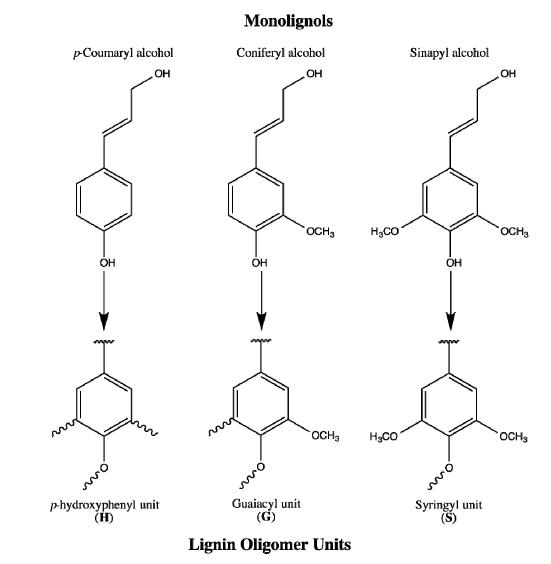
 DownLoad:
DownLoad: 